NYC’s Forgotten ‘War on Christmas Trees’
Discover how an obscure holiday crackdown affects festive street vendors today!


Welcome to part two of our series on the reuses of former homes. Today we’ll take a look at the world of Aaron Burr ghost stories, designer jeans, parrots and more in these historic buildings.
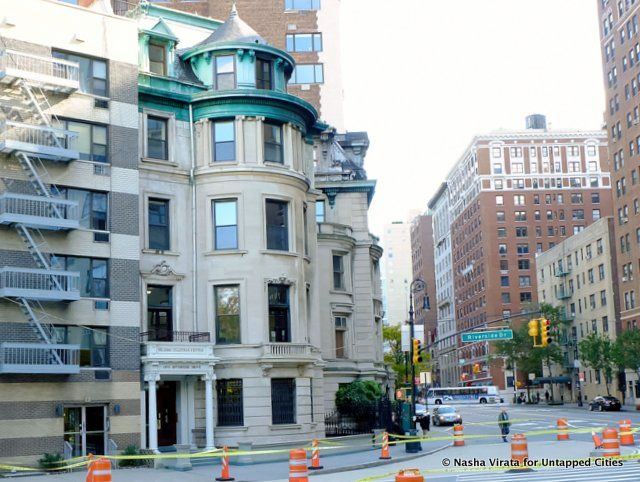
We previously covered the Islamic Cultural Center which defies the street grid on the Upper East Side. Its first incarnation however, was in the C. P. H. Gilbert-designed mansion located at 1 Riverside Drive. Not to be confused with Cass Gilbert of Woolworth Building-fame, Charles Gilbert is responsible for many Gilded Age mansions still in existence today.
The Center purchased the former Prentiss residence from the Nippon Society, a now-defunct Japanese American private club, in 1957 as a temporary headquarters. They remained for thirty-four years when unexpected funding and contractual issues resulted in their official location opening in 1991. Today, 1 Riverside Drive is still used as a satellite location for prayer and worship.
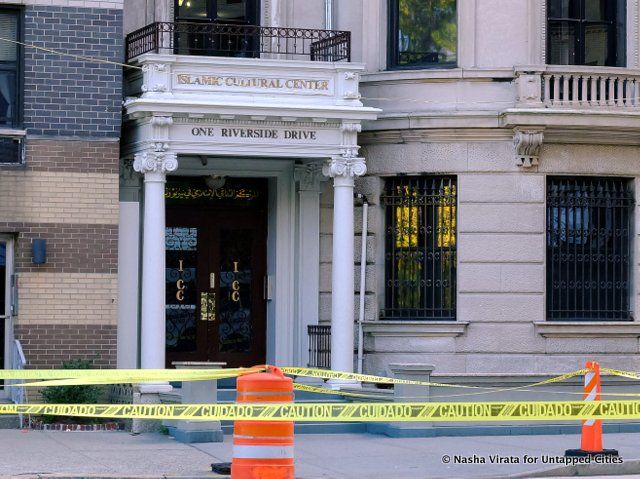
For more on New York mosques and their approach to adaptive reuse, check out their approach to a former factory and a movie theater.
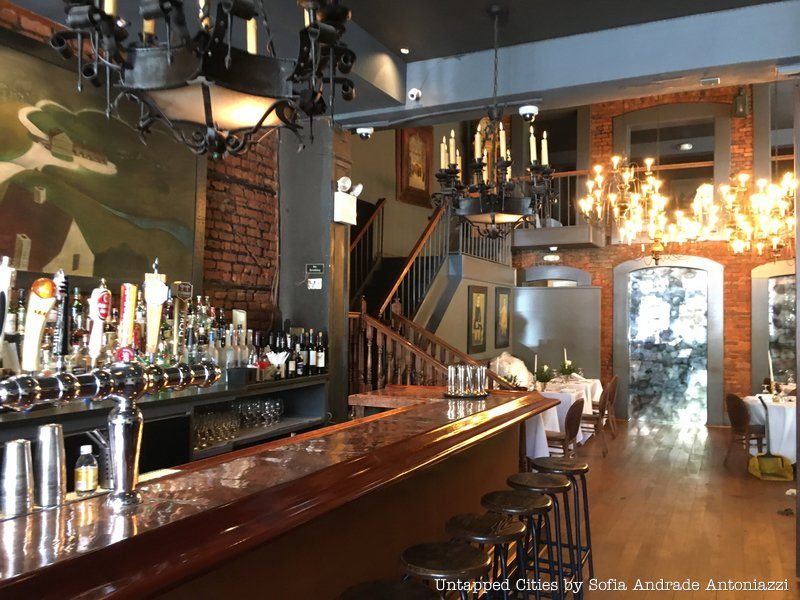
Greenwich Village is steeped both in history and urban legend. One story that often surfaces around Halloween is the haunting of upscale restaurant One if by Land, Two if by Sea. The spirit of Aaron Burr’s daughter, Theodosia, the story goes, returns to haunt her father’s former carriage house after dying in a shipwreck.
However, Aaron Burr never actually owned or leased the property and even if he had lived there regardless, it’s unlikely that his educated and upper-class daughter would be returning to haunt the carriage house. Aaron Burr after all can be traced much more robustly to many other houses in New York.
It was a Mr. Hallanan who occupied the building for most of its life as a residence. Hallanan, an inventor of horse carriage pads, used the current restaurant as his workshop, which explains the wide opening that appears more suitable to cars than horses. If Mr. Hallanan’s spirit does remain, it is a benign one. He was a well-known member of the community and sometimes called the “father of Sheridan Square.” His insistence that the neighborhood create a space to honor Philip Sheridan, a Union general in the Civil War, resulted in today’s Sheridan Square.
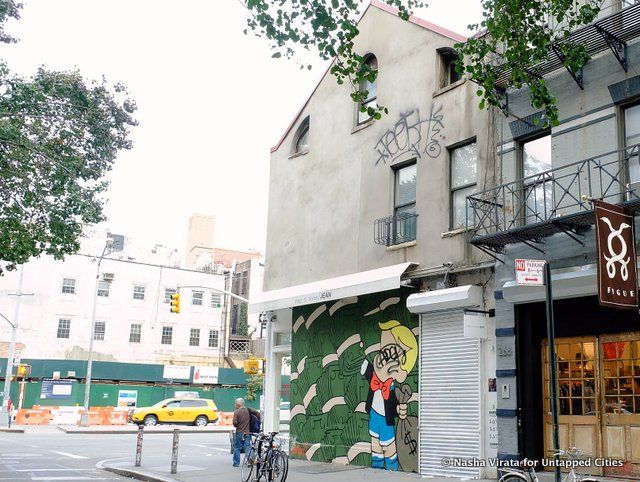
Maintaining the balance between art and commerce can be tricky. Take 73 East Houston Street on the corner of Elizabeth Street. Home to Rag & Bone, the high-end retailer in turn commissions a rotation of street artists for the Elizabeth Street exterior. The current mural by Jerkface is of a faceless Richie Rich surrounded by wads of cash, an ambivalent counterpoint to the narrow window to its side, with the luxury clothing line in full view.
Previous pieces include work by former 5Pointz curator Meres One, as well as a free-standing installation of spacemen, cosmonauts and the like by Fabrizio Moretti, drummer of The Strokes drummer who found himself constantly replacing the spacemen taken by passers-by, an ironic take on the temporary nature of street art itself. For more Jerkface works, see our Bushwick Collective and L.I.S.A. Project coverage
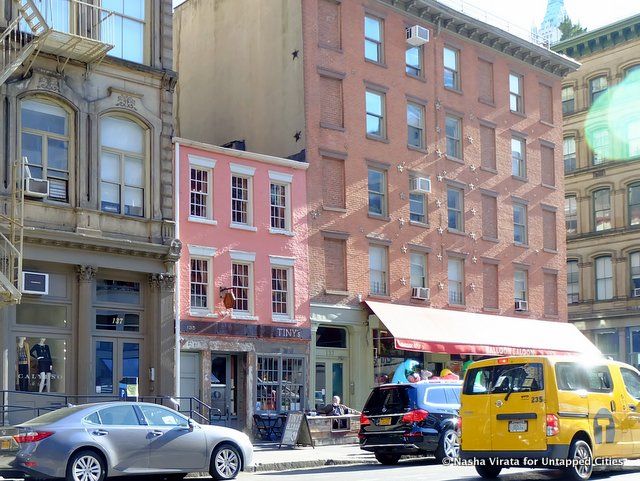
This aptly named 1801 landmarked townhouse is a defiant salmon-pink beside the more neutral colors of the Tribeca loft buildings. The restaurant and bar (which is, yes, on the second floor) is owned by New York Rangers Goalie Henry Lvndquist and Sean Avery among others. The space inside draws on other period of New York history for a rather charming spot in the middle of Tribeca.
Outside, the salmon pink joins another mishmash of periods but if you squint your eyes, you might see the house as it first looked in the 1800s. Originally clapboard, the upper stories of the structure are now clad in Flemish bond brick. The historic ground floor exterior was replaced, but the 3-bay window configuration is original.
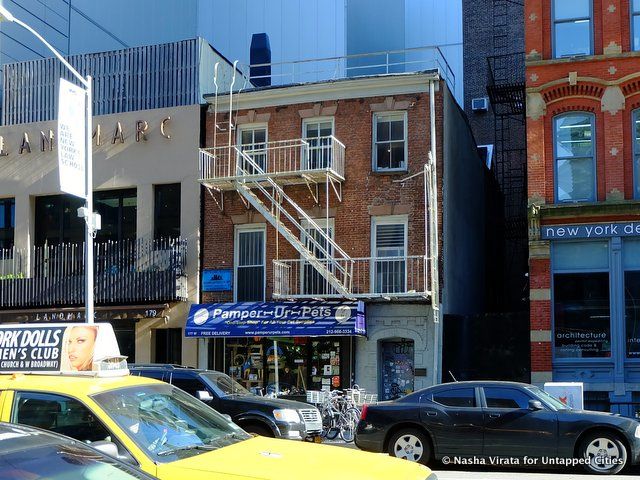
Sometimes, gentrification can only change so much. 177 West Broadway, with its distinctive Flemish bond brickwork. Currently home to the pet supply store, Pamper Ur Pets, this used to be the number one (and the only) spot in New York City to buy a parrot. Urban Bird housed a colorful pandemonium of parrots with the store owner living on the second floor.
However, the opening of nightclub Renegayde right next door meant the end for the parrots, who almost immediately found their calm evenings and coupling disturbed by the dance club’s late night raucous noise and pulsing. There is no word on other residents around the area and their attitudes on the parrots but very quickly after Renegayde opened, Urban Birds closed, replaced by another store geared towards the animal world.
Take a look at another 5 houses and their current incarnations as well as historic homes converted into museums in Manhattan, Queens, the Bronx, and on Staten Island.
Subscribe to our newsletter